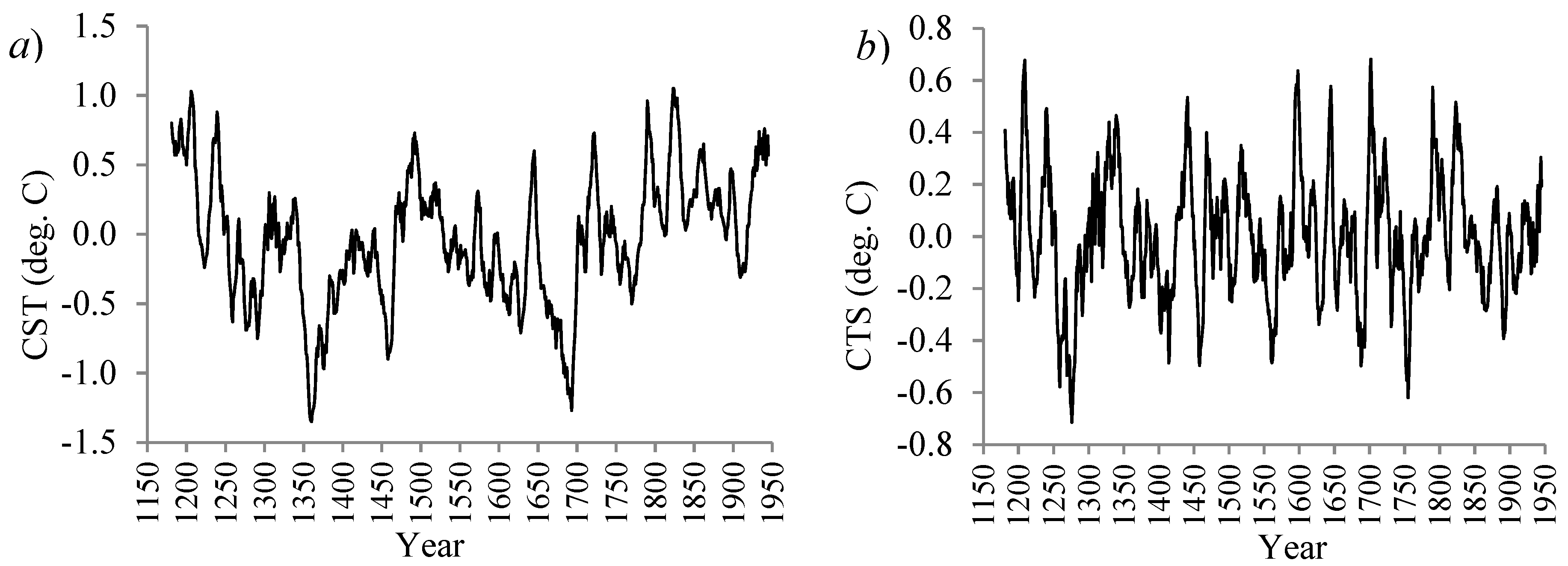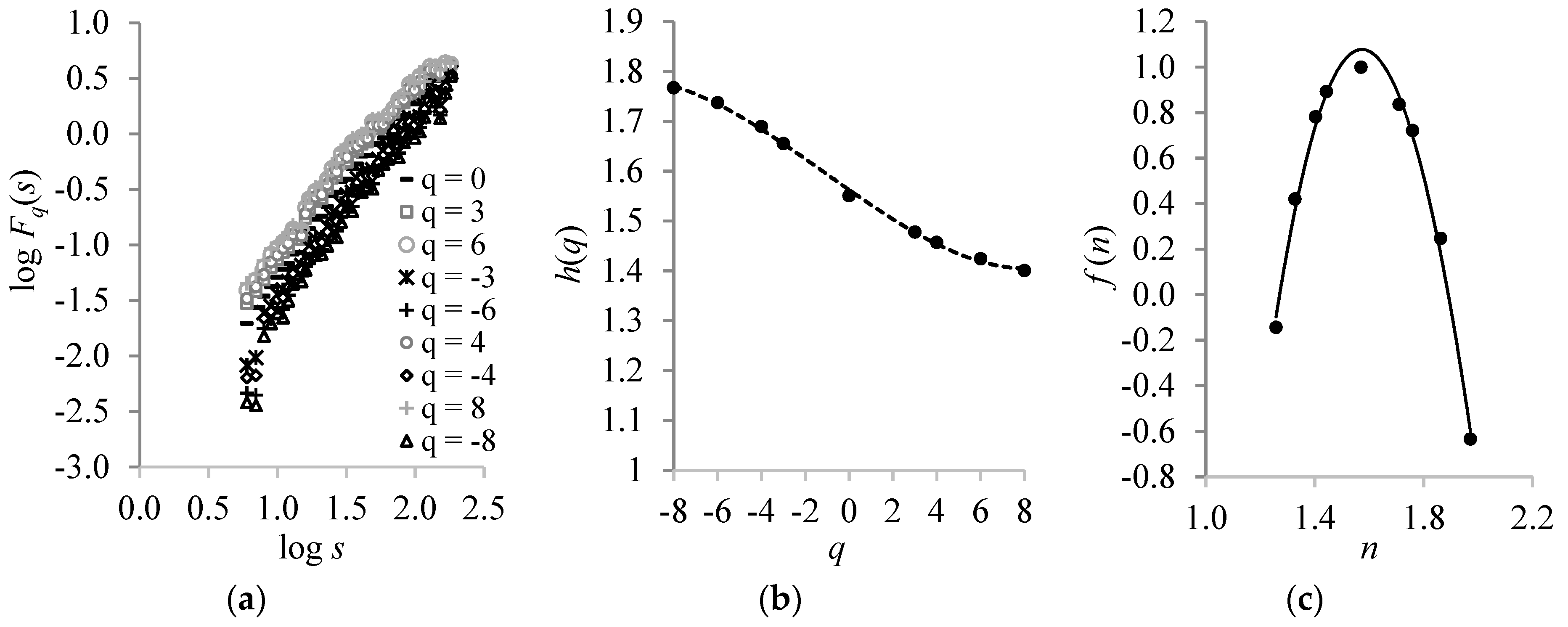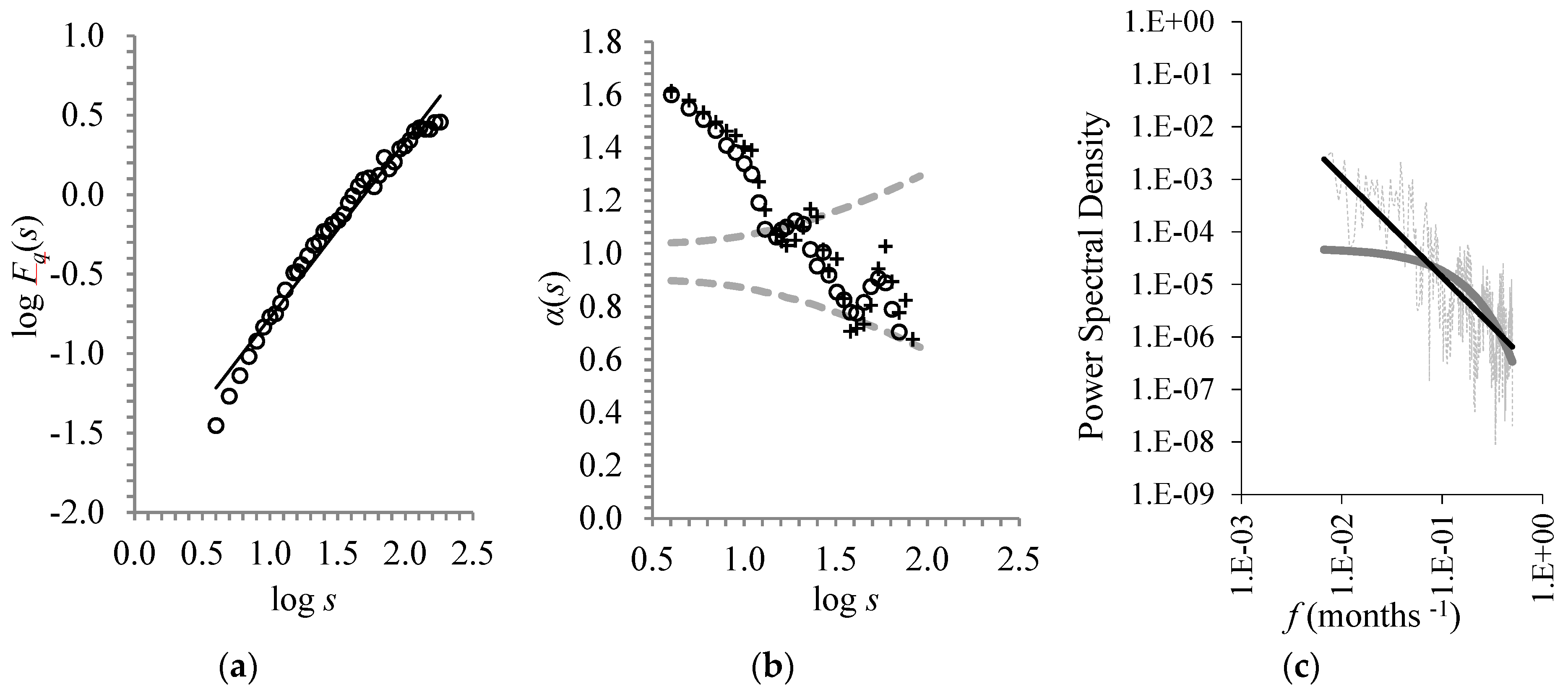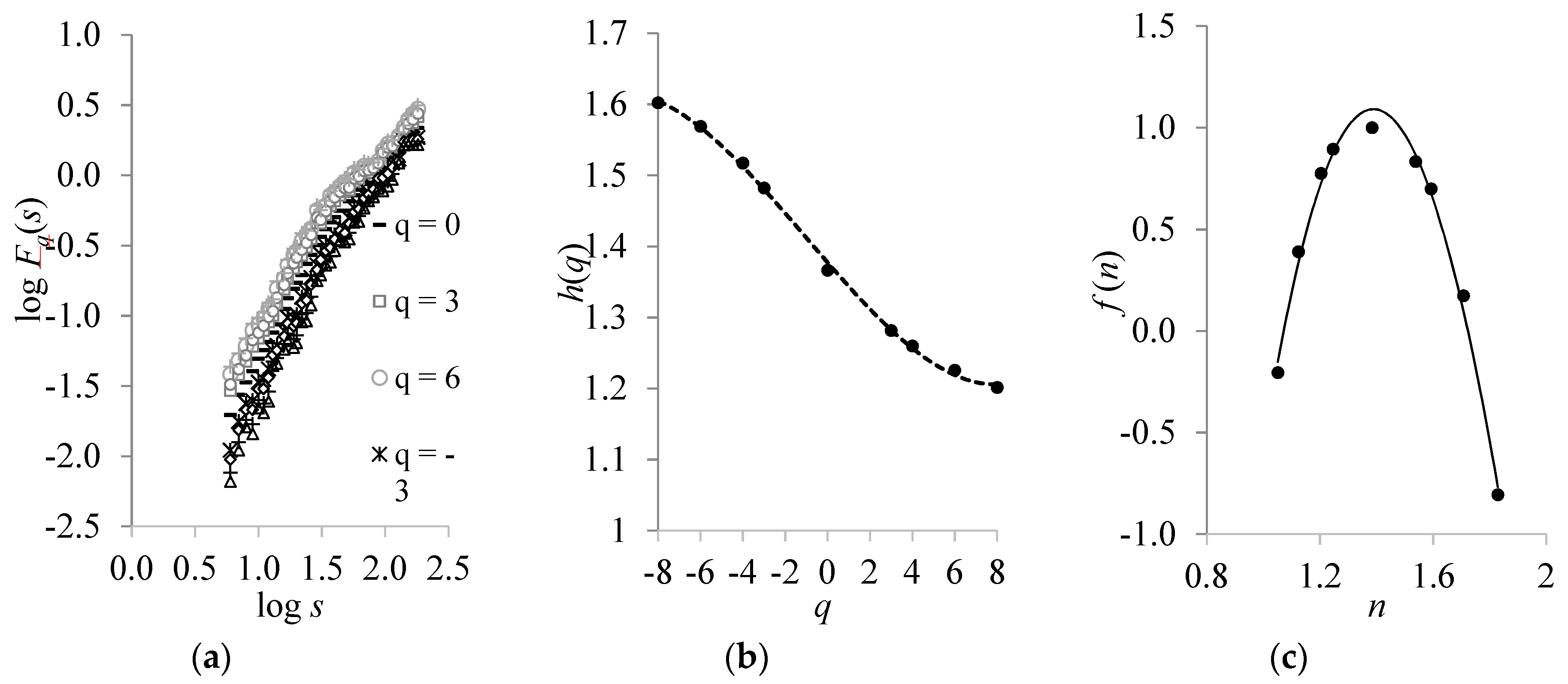Future Temperature Extremes Will Be More Harmful: A New Critical Factor for Improved Forecasts
Abstract
1. Introduction
2. Material and Methods
3. Results and Discussion
3.1. The Long Memory Effect in Ambient Temperature
- (i)
- The stability of the exponent of the power-law found above: In this respect, the calculated local slopes a(s) vs. log s (depicted in Figure 2b, for two different 10- and 12-point window sizes) are in the range (where is the average value and sa is the standard deviation of the local slopes a(s)). This demonstrates the stability of the power-law exponent to a sufficient range (i.e., after 41 years).
- (ii)
- The hyperbolic best fit of the power spectral density as a function of frequency: The best fit of the profile of the power spectral density vs. frequency is a hyperbolic curve rather than an exponential one (Figure 2c).
- (i)
- A power-law behavior was yielded by the q-th order fluctuation function Fq(s). The slopes of the linear regressions of logFq(s) vs. log s were found to be higher for the negative moments than for the positive ones, thus revealing multi-scaling dynamics (Figure 3a).
- (ii)
- The generalized Hurst exponent h(q) varied with q in a manner that h(q) > 0.5 establishing the power-law long-range correlations in the CST (Figure 3b).
- (iii)
- The fact that the h(q) values for the negative q-values were higher than the positive ones indicate that the CST exhibited multifractality with different behavior for the positive and negative moments (Figure 3b). This means that low and high temperature fluctuations obey the power-law with different exponents.
3.2. The Long Memory Effect in the Background of Ambient Temperature
3.3. The Exploitation of the Scaling Effect to Develop Improved Early Warning Systems for Air Temperature Extremes
4. Conclusions
- (i)
- The temperature record revealed persistent a power-law behavior with a single exponent over all time scales. This means that an average fluctuation in temperature in the past may create another future temperature fluctuation after several decades, with enhanced amplitude that can be calculated from the resulting power-law.
- (ii)
- Small and large fluctuations in temperature obey the power laws with different exponents.
Author Contributions
Funding
Conflicts of Interest
References
- Chang, J.; Zhang, E.; Liu, E.; Sun, W.; Langdon, P.G.; Shulmeister, J.A. 2500-year climate and environmental record inferred from subfossil chironomids from Lugu Lake, southwestern China. Hydrobiologia 2018, 811, 193–206. [Google Scholar] [CrossRef]
- Connor, S.E.; Colombaroli, D.; Confortini, F.; Gobet, E.; Ilyashuk, B.; Ilyashuk, E.; van Leeuwen, J.; Lamentowicz, M.; van der Knaap, W.O.; Malysheva, E.; et al. Long-term population dynamics–theory and reality in a peatland ecosystem. J. Ecol. 2018, 106, 333–346. [Google Scholar] [CrossRef]
- Ilyashuk, E.A.; Heiri, O.; Ilyashuk, B.P.; Koinig, K.A.; Psenner, R. The Little Ice Age signature in a 700-year high-resolution chironomid record of summer temperatures in the Central Eastern Alps. Clim. Dyn. 2019, 52, 6953–6967. [Google Scholar] [CrossRef] [PubMed]
- Mkrtchyan, F.A. On the effectiveness of remote monitoring systems. Earth Obs. Syst. 2018, 107641076415. [Google Scholar]
- Walker, I.R. Midges: Chironomidae and related diptera. In Tracking Environmental Change Using Lake Sediments; Springer: Dordrecht, The Netherlands, 2001; pp. 43–66. [Google Scholar]
- Self, A.E.; Brooks, S.J.; Birks, H.J.B.; Nazarova, L.; Porinchu, D.; Odland, A.; Jones, V.J. The distribution and abundance of chironomids in high-latitude Eurasian lakes with respect to temperature and continentality: Development and application of new chironomid-based climate-inference models in northern Russia. Quat. Sci. Rev. 2011, 30, 1122–1141. [Google Scholar] [CrossRef]
- Bajolle, L.; Larocque-Tobler, I.; Ali, A.A.; Lavoie, M.; Bergeron, Y.; Gandouin, E. A chironomid-inferred Holocene temperature record from a shallow Canadian boreal lake: Potentials and pitfalls. J. Paleolimnol. 2019, 61, 69–84. [Google Scholar] [CrossRef]
- Luoto, T.; Kotrys, B.; Płóciennik, M. East European chironomid-based calibration model for past summer temperature reconstructions. Clim. Res. 2019, 77, 63–76. [Google Scholar] [CrossRef]
- Tsakalos, E.; Christodoulakis, J.; Charalambous, L. The dose rate calculator (DRc) for luminescence and ESR dating—A java application for dose rate and age determination. Archaeometry 2016, 58, 347–352. [Google Scholar] [CrossRef]
- Kokelj, S.V.; Lantz, T.C.; Tunnicliffe, J.; Segal, R.; Lacelle, D. Climate-driven thaw of permafrost preserved glacial landscapes, northwestern Canada. Geology 2017, 45, 371–374. [Google Scholar] [CrossRef]
- Millan, R.; Mouginot, J.; Rignot, E. Mass budget of the glaciers and ice caps of the Queen Elizabeth Islands, Canada, from 1991 to 2015. Environ. Res. Lett. 2017, 12, 024016. [Google Scholar] [CrossRef]
- Porter, T.J.; Schoenemann, S.W.; Davies, L.J.; Steig, E.J.; Bandara, S.; Froese, D.G. Recent summer warming in northwestern Canada exceeds the Holocene thermal maximum. Nat. Commun. 2019, 10, 1631. [Google Scholar] [CrossRef] [PubMed]
- Chattopadhyay, S.; Jhajharia, D.; Chattopadhyay, G. Univariate modelling of monthly maximum temperature time series over northeast India: Neural network versus Yule–Walker equation based approach. Meteorol. Appl. 2011, 18, 70–82. [Google Scholar] [CrossRef]
- Lovejoy, S.; Varotsos, C. Scaling regimes and linear/nonlinear responses of last millennium climate to volcanic and solar forcings. Earth Syst. Dyn. 2016, 7, 133–150. [Google Scholar] [CrossRef]
- Varotsos, C.; Efstathiou, M. Has global warming already arrived? J. Atmos. Sol.-Terr. Phys. 2019, 182, 31–38. [Google Scholar] [CrossRef]
- Xue, Y.; He, X.; Xu, H.; Guang, J.; Guo, J.; Mei, L. China Collection 2.0: The aerosol optical depth dataset from the synergetic retrieval of aerosol properties algorithm. Atmos. Environ. 2014, 95, 45–58. [Google Scholar] [CrossRef]
- Varotsos, C.A.; Franzke, C.L.; Efstathiou, M.N.; Degermendzhi, A.G. Evidence for two abrupt warming events of SST in the last century. Theor. Appl. Clim. 2014, 116, 51–60. [Google Scholar] [CrossRef]
- Varotsos, C.A.; Mazei, Y.A.; Burkovsky, I.; Efstathiou, M.N.; Tzanis, C.G. Climate scaling behaviour in the dynamics of the marine interstitial ciliate community. Theor. Appl. Clim. 2016, 125, 439–447. [Google Scholar] [CrossRef]
- Available online: https://www1.ncdc.noaa.gov/pub/data/paleo/paleolimnology/europe/switzerland/silvaplana2010b.txt (accessed on 19 October 2019).
- Trachsel, M.; Grosjean, M.; Larocque-Tobler, I.; Schwikowski, M.; Blass, A.; Sturm, M. Quantitative summer temperature reconstruction derived from a combined biogenic Si and chironomid record from varved sediments of Lake Silvaplana (south-eastern Swiss Alps) back to AD 1177. Quat. Sci. Rev. 2010, 29, 2719–2730. [Google Scholar] [CrossRef]
- Wiener, N. Extrapolation, Interpolation and Smoothing of Stationary Time Series; MIT Technology Press: Cambridge, MA, USA; John Wiley and Sons: New York, NY, USA, 1950. [Google Scholar]
- Efstathiou, M.N.; Varotsos, C.A. On the altitude dependence of the temperature scaling behaviour at the global troposphere. Int. J. Remote Sens. 2010, 31, 343–349. [Google Scholar] [CrossRef]
- Efstathiou, M.N.; Varotsos, C.A. Intrinsic properties of Sahel precipitation anomalies and rainfall. Theor. Appl. Clim. 2012, 109, 627–633. [Google Scholar] [CrossRef]
- Efstathiou, M.N.; Varotsos, C.A. On the 11year solar cycle signature in global total ozone dynamics. Meteorol. Appl. 2013, 20, 72–79. [Google Scholar] [CrossRef]
- Ihlen, E.A.F. Introduction to Multifractal Detrended Fluctuation Analysis in Matlab. Front. Physiol. 2012, 3, 141. [Google Scholar] [CrossRef] [PubMed]
- Kantelhardt, J.W.; Zschiegner, S.A.; Koscielny-Bunde, E.; Havlin, S.; Bunde, A.; Stanley, H. Multifractal detrended fluctuation analysis of nonstationary time series. Phys. A Stat. Mech. Appl. 2002, 316, 87–114. [Google Scholar] [CrossRef]
- Mintzelas, A.; Sarlis, N.; Christopoulos, S.-R. Estimation of multifractality based on natural time analysis. Phys. A Stat. Mech. Appl. 2018, 512, 153–164. [Google Scholar] [CrossRef]
- Peng, C.-K.; Buldyrev, S.; Havlin, S.; Simons, M.; Stanley, H.E.; Goldberger, A.L. Mosaic organization of DNA nucleotides. Phys. Rev. E 1994, 49, 1685–1689. [Google Scholar] [CrossRef] [PubMed]
- Varotsos, C.; Assimakopoulos, M.N.; Efstathiou, M. Technical Note: Long-term memory effect in the atmospheric CO2 concentration at Mauna Loa. Atmos. Chem. Phys. 2007, 7, 629–634. [Google Scholar] [CrossRef]
- Varotsos, C.A.; Cracknell, A.P.; Efstathiou, M.N. The global signature of the El Niño/La Niña Southern Oscillation. Int. J. Remote Sens. 2018, 39, 5965–5977. [Google Scholar] [CrossRef]
- Varotsos, C.A.; Efstathiou, M.N.; Cracknell, A.P. On the scaling effect in global surface air temperature anomalies. Atmos. Chem. Phys. 2013, 13, 5243–5253. [Google Scholar] [CrossRef]
- Varotsos, C.A.; Efstathiou, M.N.; Cracknell, A.P. Plausible reasons for the inconsistencies between the modeled and observed temperatures in the tropical troposphere. Geophys. Res. Lett. 2013, 40, 4906–4910. [Google Scholar] [CrossRef]
- Weber, R.O.; Talkner, P. Spectra and correlations of climate data from days to decades. J. Geophys. Res. Space Phys. 2001, 106, 20131–20144. [Google Scholar] [CrossRef]
- Maraun, D.; Rust, H.W.; Timmer, J. Tempting long-memory–on the interpretation of DFA results. Nonlinear Process. Geophys. 2004, 11, 495–503. [Google Scholar] [CrossRef]
- Varotsos, C.A.; Sarlis, N.V.; Efstathiou, M. On the association between the recent episode of the quasi-biennial oscillation and the strong El Niño event. Theor. Appl. Climatol. 2018, 133, 569–577. [Google Scholar] [CrossRef]
- Varotsos, C.A. The global signature of the ENSO and SST-like fields. Theor. Appl. Climatol. 2013, 113, 197–204. [Google Scholar] [CrossRef]
- Varotsos, C.A.; Efstathiou, M.N. Is there any long-term memory effect in the tropical cyclones? Theor. Appl. Climatol. 2013, 114, 643–650. [Google Scholar] [CrossRef]
- Varotsos, P.A.; Sarlis, N.V.; Skordas, E.S. Scale-specific order parameter fluctuations of seismicity before mainshocks: Natural time and Detrended Fluctuation Analysis. EPL 2012, 99, 59001. [Google Scholar] [CrossRef]
- Graham, H.; White, P.; Cotton, J.; McManus, S. Flood- and Weather-Damaged Homes and Mental Health: An Analysis Using England’s Mental Health Survey. Int. J. Environ. Res. Public Health 2019, 16, 3256. [Google Scholar] [CrossRef]
- De Perez, E.C.; Van Aalst, M.; Bischiniotis, K.; Mason, S.; Nissan, H.; Pappenberger, F.; Stephens, E.; Zsoter, E.; Van Den Hurk, B. Global predictability of temperature extremes. Environ. Res. Lett. 2018, 13, 054017. [Google Scholar] [CrossRef]





© 2019 by the authors. Licensee MDPI, Basel, Switzerland. This article is an open access article distributed under the terms and conditions of the Creative Commons Attribution (CC BY) license (http://creativecommons.org/licenses/by/4.0/).
Share and Cite
Varotsos, C.A.; Mazei, Y.A. Future Temperature Extremes Will Be More Harmful: A New Critical Factor for Improved Forecasts. Int. J. Environ. Res. Public Health 2019, 16, 4015. https://doi.org/10.3390/ijerph16204015
Varotsos CA, Mazei YA. Future Temperature Extremes Will Be More Harmful: A New Critical Factor for Improved Forecasts. International Journal of Environmental Research and Public Health. 2019; 16(20):4015. https://doi.org/10.3390/ijerph16204015
Chicago/Turabian StyleVarotsos, Costas A., and Yuri A. Mazei. 2019. "Future Temperature Extremes Will Be More Harmful: A New Critical Factor for Improved Forecasts" International Journal of Environmental Research and Public Health 16, no. 20: 4015. https://doi.org/10.3390/ijerph16204015
APA StyleVarotsos, C. A., & Mazei, Y. A. (2019). Future Temperature Extremes Will Be More Harmful: A New Critical Factor for Improved Forecasts. International Journal of Environmental Research and Public Health, 16(20), 4015. https://doi.org/10.3390/ijerph16204015





